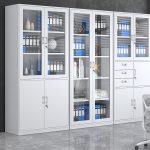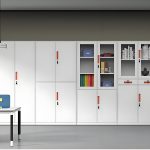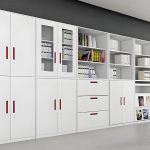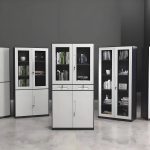Selecting the right steel filing cabinet sizes for office often feels more complicated than it should be. Between standard sizes, custom options, and varying storage needs, it's easy to feel overwhelmed. The perfect filing cabinet should maximize your space while providing easy access to your important documents.
I've created this comprehensive guide to help you find the ideal steel filing cabinet sizes for your specific requirements.
Standard Steel Filing Cabinet Dimensions
Most offices can meet their needs with standard-sized steel filing cabinets. These are the workhorses of document storage, designed to handle letter-size and legal-size documents while fitting comfortably in office environments.
The most common standard size for a vertical cabinet is approximately:
- Height: 1800-1850mm (71-73 inches)
- Width: 850-900mm (33-35 inches)
- Depth: 400-500mm (16-20 inches)
There's a reason why many cabinets are 1850mm tall rather than 1800mm - this slightly extra height ensures that standard A4 file boxes can stand upright without having to be angled into position.
For offices with limited space, lateral filing cabinets (wider and shorter) might be a better option. These typically measure around 850mm wide × 420mm deep × 1880mm high, offering similar storage capacity while fitting better under windows or along wider walls.
Assess Your Storage Needs
Before measuring your space or shopping for cabinets, take time to evaluate what you'll be storing. The type and volume of documents will directly determine the size cabinet you need.
Consider your document types:
- Letter-size documents (standard in the US): Require at least 400mm depth
- A4 documents (standard in many other countries): Fit comfortably in 400mm depth cabinets
- Legal-size documents: Need deeper cabinets, typically 450-500mm
- Bindered materials: Require additional height between shelves
Estimate your volume capacity:
A standard file cabinet drawer can typically hold 400-600 file folders. If you have extensive archives, you might need multiple cabinets or consider high-density mobile shelving systems.
For specialized storage needs like medical records, accounting documents, or inventory parts, you might benefit from specialty cabinets like multi-drawer units with smaller compartments.
Measure Your Available Space
Once you know your storage requirements, it's time to measure your physical space accurately. Even the perfectly-sized cabinet on paper won't work if it doesn't fit in your office.
Critical measurements to take:
- Floor space: Note the exact length and width where the cabinet will reside
- Doorway and hallway clearance: Ensure the cabinet can actually reach its destination
- Ceiling height: Particularly important for taller cabinets
- Swing space: For front-opening cabinets, account for door clearance
- Workspace around cabinet: Leave room for comfortable access
A pro tip: Use painter's tape to mark out the cabinet footprint on your floor. This visual representation will help you judge if the size works in your actual space.
Don't forget to consider future needs too. If your business is growing, you might want to allocate space for additional cabinets down the road.
Specialized Steel Cabinet Options
Beyond standard vertical filing cabinets, several specialized options might better suit specific needs:
1. Lateral Filing Cabinets
These wider, shorter cabinets are ideal for spaces where you need to store files under windows or along wide walls. They typically offer similar capacity to vertical cabinets but in a different form factor. Common sizes range from 1180mm wide for 2-drawer models up to 1800mm for 4-drawer units.
2. Multi-Drawer Storage Cabinets
For organizing small parts, samples, or categorized documents, multi-drawer steel cabinets provide exceptional organization. These units typically feature numerous small drawers in a compact frame, with sizes like 453mm × 357mm × 255mm being common.
3. High-Capacity Mobile Shelving
If you need maximum storage in minimal space, consider high-density mobile shelving systems. These innovative units glide on tracks to eliminate unnecessary aisles, potentially doubling your storage capacity in the same floor space.
Cabinet Selection Checklist
As you evaluate different steel filing cabinet sizes, use this checklist to ensure you're making the right choice:
- Documents fit properly - Test with your actual files if possible
- Drawers operate smoothly - Ensure full extension without binding
- Weight capacity is adequate - Steel cabinets should handle heavy loads
- Safety features are present - Look for anti-tip mechanisms
- Security meets needs - Choose appropriate locking mechanisms
- Mobility is possible - Consider models with casters if relocation might be needed
- Delivery and installation - Account for getting the cabinet into position
When to Consider Custom Sizing
While standard cabinets meet most needs, sometimes custom sizing is worth the investment. Consider custom options if you have:
- Non-standard ceiling heights that you want to maximize
- Unique room dimensions with awkward proportions
- Specific storage requirements that standard products can't address
- Architectural constraints like sloped ceilings or protruding elements
Most manufacturers offer custom sizing, though typically at a premium price and with longer lead times.
Maximize Your Cabinet Investment
Finding the right size steel filing cabinet involves careful consideration of your documents, your space, and your workflow. By taking accurate measurements and honestly assessing your storage needs, you can select a cabinet that will serve you well for years to come.
Remember that the best filing cabinet is one you hardly notice - it simply works seamlessly with your office environment and workflow while keeping your important documents secure and accessible.
Still unsure about the size of the steel filing cabinet you need? DongZhiXin Office Furniture offers space planning services and can provide professional recommendations based on your specific needs. Feel free to leave a message or email [email protected] for inquiries.





